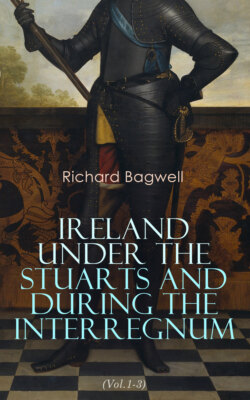Читать книгу Ireland under the Stuarts and During the Interregnum (Vol.1-3) - Bagwell Richard - Страница 26
FOOTNOTES:
Оглавление[173] Welwood’s Memoirs of the most Material Transactions, etc., being short and well written, may have had a good deal to say to forming public opinion. There are a great many editions, and Lord Chatham praised the book. Wentworth to Conway, January 20, 1625–6 in State Papers, Domestic. Wentworth’s letter to Sir Robert Askwith, December 7, 1620, is in Camden Miscellany, vol. ix. Other electioneering letters are in the Strafford Letters, i. 8–13. Hobbes says it is hard to judge motives, but that Wentworth’s promotion was a sign of the King’s weakness, ‘for in a market where honour and power is to be bought with stubbornness, there will be a great many as able to buy as my Lord Strafford was’ (Behemoth, part ii.)
[174] Hacket’s Life of Williams, pt. ii. p. 67, ed. 1692; Heylin’s Life of Laud, pt. i. lib. 3, pp. 184, 196, ed. 1671; Laud to Wentworth, July 30, 1632 (misprinted 1631), April 30, and September 9, 1633, Strafford Letters; Wentworth to Laud, October 1633, ‘in a letter not printed,’ Additional MSS., 38, 538, f. 197. See also Gardiner’s History of England, vii. 152.
[175] Wentworth to Coke, August 3, 1633; to Lord Treasurer Weston, January 31, 1633–4, Strafford Letters; The King to Radcliffe, November 13, 1632 in State Papers, Ireland, and to the Lord Deputy, ib. May 17, 1633.
[176] Philip Mainwaring to Wentworth, October 29, 1630; Laud to Wentworth, March 11 and October 20, 1634; the King to Wentworth, June 16, 1634, in Strafford Letters.
[177] Howell’s Letters, July 1, 1629. Viscount Wilmot to Cottington, January 10, 1631–32; Weston to Wentworth, October 11, 1631; Wentworth to Sir E. Stanhope, October 25—all in Strafford Letters. The letter from Laud placed by Knowler at July 30, 1631, certainly belongs to 1632, when Wentworth was meditating his passage to Ireland (Laud’s Works, vi. 300).
[178] The King to the Lords Justices, January 12, April 14, 1632; the Lord Deputy’s Propositions, February 22; Wentworth to the Lords Justices, January 18, October 15; Sir W. Parsons to Wentworth, February 4; Lord Cottington to Wentworth, October 18; Wentworth to Weston, October 21—all in Strafford Letters.
[179] Wentworth to Cottington, October 1, 1632; to Lord Mountnorris, August 19; to the Lords Justices, October 15, Strafford Letters.
[180] The Lords Justices to Wentworth, February 26, 1631–2; Wentworth to Lord Carlisle, May 20; to Weston, June 9; to Coke, August 3; Edward Christian to Wentworth, October 4, all in Strafford Letters. Captain Plumleigh to Nicholas, July 29, 1633, in State Papers, Ireland. Court and Times, ii. 189.
[181] Earl of Cork’s Diary, 23–25 July, 1633, in Lismore Papers, 1st series, ‘a most cursed man to all Ireland and to me in particular.’ Wentworth’s friendly visit on the 24th is noted. Newsletter from Walsingham Gresley for Lord Bristol’s information in Additional MSS. 29, 587, f. 17. Wentworth to Coke, August 3, 1633; to Essex, April 13, 1634, in answer to his letter of February 18, Strafford Letters. Shirley’s Hist. of Monaghan, 265.
[182] Lismore Papers, 1st series, iii. 203; Gresley’s newsletter, ut sup.; Captain Plumleigh to Nicholas, July 29, 1633, in State Papers, Ireland; Radcliffe’s statement in Strafford Letters, ii. 430. Wentworth had been privately married in the previous October to Elizabeth, daughter of Sir Godfrey Rhodes, only one year after his second wife’s death. The shortness of the time may have been a reason for concealment, and once in Dublin it was evidently desirable that she should not become the centre of intrigue in her husband’s absence.
[183] Wentworth to Weston and Coke, August 3, 1633, in Strafford Letters, and to Carlisle, August 27, in vol. viii. of the Camden Miscellany, p. 5.
[184] Wilmot to Cottington, January 10, 1631–2; the King to Wentworth, May 27, 1633; Wentworth to Coke, January 31, 1633–4. As to the King’s excuse for appointing Cary, see Lord Carlisle to Wentworth, February 10, 1633–4, Strafford Letters. Third Report of Hist. MSS. Comm. 283, August 4, 1634. Clarendon’s Hist. of the Rebellion, vol. i. p. 184 in Macray’s edition.
[185] Laud to Wentworth, July 30, 1631, in Strafford Letters; Bramhall to Laud, August 10, 1633, in the Oxford ed. of Bramhall’s Works, i. lxxix.
[186] Mason’s Hist. of St. Patrick’s; Budgell’s Memoirs of the Boyles; Laud to Wentworth, November 15, 1633, March 11, 1633–4; Wentworth to Laud, August 23, 1634, March 10, 1634–5, in Strafford Letters. The King’s letter is in Lismore Papers, 2nd series, iii. 194. Elrington’s Life of Ussher, p. 159.
[187] The documents concerning Baltimore are printed in Caulfield’s Council Book of Kinsale, xxxiii. Smith’s Hist. of Cork. Cal. of State Papers, Ireland, 1631, No. 1973. Conway to Wentworth, July 14, 1636, in Strafford Letters. Court and Times, ii. 253, 259, 265. The Baltimore of 1630 did not occupy the same ground as the modern fishing village, but ran inland from O’Driscoll’s castle. Thomas Davis wrote a fine ballad on the sack of Baltimore:
High upon a gallows tree, a yelling wretch is seen,
’Tis Hackett of Dungarvan—he, who steered the Algerine!
He fell amid a sullen shout, with scarce a passing prayer,
For he had slain the kith and kin of many a hundred there.
[188] Strafford Letters, passim, from 1633 to 1637; see particularly Plumleigh’s letter of October 11, 1633.
